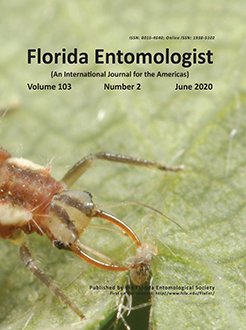During our study on egg parasitoids of the kudzu bug in Florida, we collected egg masses of Megacopta cribraria on kudzu and catnip for laboratory rearing. We found a new egg parasitoid, Ooencyrtus nezarae on M. cribraria, which represents the first Florida record of this parasitoid species. The wasp is widely distributed in Asia, and it will strengthen biological control of the kudzu bug in Florida. Future studies will assess comparative parasitism levels of Paratelenomus saccharalis and O. nezarae, as well as the dynamics of populations of these biological control agents.
The kudzu bug Megacopta cribraria (F.) (Hemiptera: Plataspidae) is a pest of concern for farmers in many legume-producing states (Gardner et al. 2013a). Since it was first detected in Georgia in 2009, M. cribraria has rapidly expanded its range across the Southeast (Eger et al. 2010; Gardner et al. 2013a). With a high reproductive potential, M. cribraria is able to complete up to 3 generations per yr in Asia (Tayutivutikul & Yano 1990), and 2 generations per yr in the southeastern USA (Zhang et al. 2012). Megacopta cribraria is known for its potential to reduce the biomass of kudzu (Pueraria montana var. lobata (Willd.) Sanjappa & Pradeep; Fabaceae) up to 33% (Zhang et al. 2012), but it also attacks soybeans (Glycine max [L.] Merr.; Fabaceae) and other legumes (Del Pozzo-Valdivia & Reisig 2013; Medal et al. 2013).
Megacopta cribraria is a phloem feeder, and feeding by nymphs and adults on leaves, petioles, and stems weakens plants and reduces yield (Seiter et al. 2013). In the southeastern USA, M. cribraria was reported to reduce crop yields of soybeans in untreated fields upwards of 47%, although the average yield loss was 18% (Ruberson et al. 2013); in contrast, losses from controlled experimental plots approached 60% (Seiter et al. 2013).
In 2013, native natural enemies provided little control of kudzu bugs, but other strategies such as introduction of parasitoid wasps (Ruberson et al. 2013) and the fungus Beauveria bassiana (Bals.-Criv.) Vuill. (Cordycipitaceae) showed promise as natural controls (Seiter et al. 2014). Two important families of hymenopteran egg parasitoids are found on M. cribraria within its native range. Females of both Ooencyrtus nezarae Ishii (Hymenoptera: Encyrtidae) and Paratelenomus saccharalis (Dodd) (Hymenoptera: Platygastridae) (Fig. 1) attack eggs of M. cribraria in Asia (Hirose et al. 1996; Wu et al. 2006; Hoshino et al. 2017).
In 2013, 4 yr after the discovery of the kudzu bug in Georgia, P. saccharalis was found parasitizing kudzu bugs in Georgia and Alabama (Gardner et al. 2013b); in 2014, it was found in Florida (Medal et al. 2015). Paratelenomus saccharalis is host specific and attacks only members of the Plataspidae. In contrast, females of O. nezarae are generalists known to parasitize eggs of 13 hemipteran species in the families Plataspidae, Pentatomidae, Coreidae and Alydidae (Zhang et al. 2005). Species of Ooencyrtus are distributed widely in Korea, Japan, and China (Hoshino et al. 2017), and have been reported recently in North America (Dhammi et al. 2016; Ademokoya et al. 2018) and India (Gupta & Sharanabasappa 2016). Ooencyrtus and Paratelenomus are known to co-exist (Hoshino et al. 2017), and a combined parasitism rate in China for a platygastrid and a species of Ooencyrtus (mainly O. nezarae) on M. cribraria in soybeans from May to Jun 2002 reached 95% (Zhang et al. 2003).
In our study of P. saccharalis on M. cribraria in Florida, we collected eggs of the kudzu bug from selected sites and host plants (kudzu, soybean, and catnip). We found unusual parasitic damage on M. cribraria egg masses, and the exit holes were at the base of the eggs (Fig. 2) instead of at the cap as in P. saccharalis (Fig. 2). We collected additional egg masses and placed them in plastic containers with ventilated covers to be transported to the laboratory for rearing to adult stage.
Two parasitoid species emerged from the egg masses: one was P. saccharalis, and the other was first identified as Ooencyrtus sp. by E. Talamas (Division of Plant Industry, Florida Department of Agriculture and Consumer Services, Gainesville, Florida, USA), and we further identified it to be O. nezarae, based on details given in Ademokoya et al. (2018) and identical exit holes (Fig. 2). The level of parasitism was 24% for O. nezarae and 37% for P. saccharalis on 300 eggs tested. Both parasitoids did not emerge on the same day. Seventy percent (70%) of the time where both parasitoids parasitized a single egg mass, O. nezarae was the first to emerge. Ooencyrtus nezarae is a facultative gregarious egg parasitiod (Ademokoya et al. 2018).
We wish to express our gratitude to USDA-APHIS and USDA-ARS for funding and overall support, and the Center for Biological Control, College of Agriculture and Food Sciences, Florida A&M University. We thank E. Talamas, Division of Plant Industry, Florida Department of Agriculture and Consumer Services, Gainesville, for assistance in parasitoid identification. Special thanks also to Janice Peters for her assistance throughout this project, and Rodrigue Pierre, Walker Jones, Danielle Wolaver, Neil Miller, and Andrew Merwin for technical assistance with this study.







